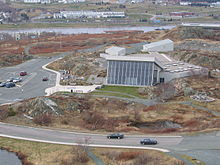We spent three amazing weeks in Newfoundland Labrador and I
have to emphasize that it should be on everyone’s “Must See” List if at all
possible.
The geology is ancient beyond human comprehension. See post
#106.
The wildlife is fascinating.
June was a great month to see icebergs and puffins but early to see many whales.
As we were waiting for the ferry back to Cape Breton I
chatted with a Newfoundland couple who gave me this souvenir of their home.
Our hostess, Mary, in L’anse au Loup gave us personal insights into life in Labrador over the last 80 years.
Local entertainment is unique to the Island.
Cod fishing provided the first explorers and settlers their
livelihood and was the mainstay for centuries. Cash was scarce and the economy
operated largely on a system of credit where cod became known as “Newfoundland
Currency”.
When Newfoundlanders talk about fish it is cod. All other
fish are named, but cod is just “fish”. No further name or explanation needed.
The 1992 moratorium on cod fishing was a crippling blow to
the Newfoundland economy. However, its people are resilient and looked toward
another source of wealth from the sea – oil. The Hibernia Oilfield brought jobs
to the province and a renewed sense of hope for the future.
Fort McMurray Oil Sands provided long distance jobs.
Newfoundlanders and Labradorians are determined and resourceful people and will go
to great lengths to maintain their unique lifestyle and traditions.
Newfoundland Labrador was the highlight of our “Circle Tour
of the US and Canada”.



























































